The first cross-referenced inspections have been completed and notifications have been sent to vehicle owners whose vehicles are uninsured or have unpaid circulation fees, aimed at improving road safety for drivers and citizens overall, ensuring safe vehicle circulation, and reducing traffic accidents and fatalities. This is a substantial initiative aimed at improving driving behavior and is implemented through cooperation between the Ministries of National Economy and Finance, Digital Governance, Infrastructure and Transport, Citizen Protection, as well as the Independent Authority for Public Revenue (IAPR).
Which cases do the cross-referenced vehicle inspections cover
Specifically, the cross-referenced inspections focus on identifying vehicles that are circulating uninsured, without having paid circulation fees, or without having completed mandatory vehicle inspection checks. They are conducted within the framework of Law 5113/2024 and the overall action to create a unified picture of vehicle data and ensure vehicle owners comply with their legal obligations, based on data from competent authorities.
In the first phase, notifications are sent for non-compliance with insurance and circulation fee payments. More specifically, the following are sent immediately: a) 100,971 notifications to citizens and 7,810 to legal entities, totaling 108,781 for insurance non-compliance. b) 101,721 notifications to citizens and 8,316 to legal entities, totaling 110,037, concerning non-compliance with circulation fee payments.
How citizens are notified
Citizens and legal representatives of legal entities are notified via SMS, email, or mail, depending on the available contact information in public registries. Specifically, those who have declared their details in the National Communication Registry (emep.gov.gr) will receive notifications via SMS and email from the General Secretariat of Information Systems and Digital Governance. The rest will be notified by email from IAPR. In exceptional cases where communication through the above methods is not possible, notifications will be sent by mail. Interested parties can check the results of cross-referenced inspections concerning their vehicle, either through gov.gr in the “Property and Taxation” category and “Vehicles” subcategory, or directly at oximata.gov.gr. Access to the new application of the Ministry of Digital Governance is done using taxisnet credentials.
The purpose of the first phase is for citizens to be informed about compliance violations identified with reference date August 25, 2025, so they can comply with circulation fee payment obligations and vehicle insurance within 15 days. After the 15-day period expires and new cross-referenced inspections are completed, citizens and legal entities who did not comply will receive notifications with certified fines through the aforementioned methods (SMS, email, mail). In the case of uninsured vehicles, fines will range from €250 to €1,000 depending on the vehicle type. Fine amounts for non-payment of circulation fees vary based on vehicle category.
Cross-referenced inspections are conducted by the General Secretariat of Information Systems and Digital Governance of the Ministry of Digital Governance, in cooperation with the Ministries of National Economy and Finance, Infrastructure and Transport, Citizen Protection, as well as the Independent Authority for Public Revenue (IAPR), coordinated by the Government Presidency. The inspections utilize data from the Supplementary Insurance Fund for Liability from Motor Vehicle Accidents and Alternative Vehicle Management Greece (EDOE).
It should be noted that, for the first time, vehicle data is being cross-referenced from all registries of competent authorities, which until today show significant discrepancies among them, often causing inconvenience for citizens. This capability was achieved through data control, cleaning, and standardization procedures. The action aims to definitively eliminate problems arising from lack of common vision, create a unified mechanism for monitoring owner obligation compliance, and establish a stable and reliable framework for safe vehicle circulation.




